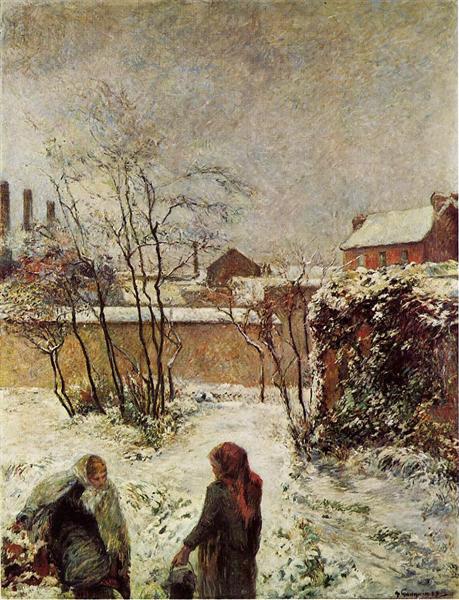Description
The painting "The Garden in Winter - Rue Carcel" by Paul Gauguin, created in 1883, is a work that reflects the artist's transition towards a style that, although it was still immersed in impressionism, began to glimpse the nuances of symbolism and Personal approach that would later define their career. Located on the Rue Ccel of Paris, this garden represents a moment of introspection and contemplation, an intimate connection between the observer and a daily space whose textures and atmospheres are meticulously represented.
The garden in this work is an intimate and perhaps melancholic corner, which evokes sensations of nostalgia and loneliness. The composition is marked by a predominant colored palette in dark and terrible tones, where the green shots, brown tones and yellow and red notes predominate, which create a contrast although subtle with the winter cold of the background. These colors not only define the winter season, but suggest the artist's emotional state. Through the use of a loose and thick brushstroke technique, Gauguin captures the essence of the place and its quiet, almost reverential atmosphere.
The presence of naked trees, with branches that extend weakly, and a sky that seems to oppress with its palettee gray, establishes a melancholic and reflective tone. The lack of human figures in the garden deepens this sense of isolation, which allows the viewer to project their own emotions on the scene. However, despite the absence of animated subjects, the details of nature talk about life and their stillness at a specific time, reflecting Gauguin's goal of capturing the essentials in their environment.
It is interesting to note that "the garden in winter" is not at the time of its creation in an isolated context, but is part of a broader exploration of life in Paris and the search for what it meant to be an artist in that time. Gauguin was, at that time, influenced by his experiences in the Parisian art world, as well as the works of other contemporary artists, including Camille Pissarro and Édouard Manet, who had begun to distance themselves from the most academic techniques towards a more personal representation and Poetics of reality.
This work also offers an advance of Gauguin's subsequent interest in simplification and the use of color as a means to express emotions rather than following the objective representation of reality. The color application technique in "the garden in winter" can be considered a precursor to its boldest style, which would be seen in subsequent works, where the use of color becomes the main axis of its pictorial language.
Through "The Garden in Winter - Rue Carcel", Gauguin not only documes a place or a station, but summons spectators to an introspective mood. The painting acts as a mirror of its own struggles and reflections, and at the same time, leaves an open door so that each can explore their personal narrative in the garden that the artist has chosen to immortalize. The work is erected, thus, as a testimony of Gauguin's transition towards his future as one of the pioneers of symbolism and post -impressionist painting, inviting a deeper appreciation of the environment and his intrinsic emotions.
KUADROS ©, a famous paint on your wall.
Hand-made oil painting reproductions, with the quality of professional artists and the distinctive seal of KUADROS ©.
Reproduction service paintings With a guarantee of satisfaction. If you are not completely satisfied with the replica of your painting, we refund your money 100%.

